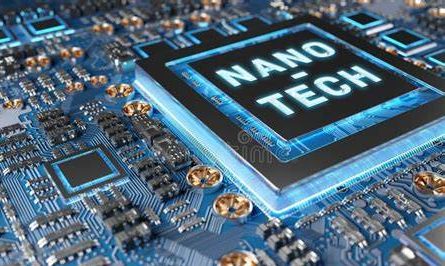Imagine a world where your smartphone fits on your fingertip, yet holds the processing power of a supercomputer. Or picture flexible displays rolled up like a newspaper, yet showcasing vibrant visuals. Believe it or not, this futuristic vision might not be as far-fetched as it seems. Nanotechnology, the manipulation of matter at the atomic and molecular level, is rapidly transforming the world of electronics, paving the way for a future where smaller is mightier.
What in the World is Nanotechnology? (Beyond the Microscopic)
Before we delve into the mind-blowing applications of nanotechnology in electronics, let’s shrink down to size and understand this revolutionary field. Nanotechnology operates at the nanoscale, a realm where the rules of physics take a surprising turn. One nanometer is a billionth of a meter, so small that a human hair is roughly 80,000 nanometers wide! At this miniscule scale, materials exhibit unique properties that differ significantly from their bulk counterparts. Imagine a lump of clay suddenly becoming a powerful conductor of electricity – that’s the kind of magic nanotechnology unlocks!
By manipulating materials at the atomic level, scientists can tailor their properties to create entirely new functionalities. This allows for the development of revolutionary new materials with specific characteristics, like exceptional strength, enhanced conductivity, or even the ability to emit light.
The Electronics Revolution: How Nanotechnology is Reshaping Our Devices (From Gigantic to Miniscule)
The impact of nanotechnology on electronics is nothing short of phenomenal. It’s fueling a miniaturization revolution, enabling us to pack more power and functionality into smaller and smaller devices. Remember those clunky brick phones from the 80s? Nanotechnology is making it possible to condense that processing power into sleek smartphones that fit comfortably in your palm.
But miniaturization is just the tip of the iceberg. Nanotechnology is also enhancing the performance of our electronics in several ways:
- Faster Processing Speeds: Nanomaterials can conduct electricity with incredible efficiency, leading to faster processing speeds and improved responsiveness in our devices.
- Increased Durability: Nanotech-based materials can be incredibly strong and lightweight, making our electronics more resistant to damage and wear-and-tear.
- Enhanced Battery Life: Nanotechnology is paving the way for the development of more efficient batteries that can hold a charge for longer periods.
Perhaps the most exciting aspect of nanotechnology in electronics is the potential for entirely new types of devices. Imagine flexible displays that can be rolled up or even worn like clothing! The possibilities are truly endless, thanks to the unique properties of nanomaterials.
A Glimpse into the Nanotech Toolbox: The Building Blocks of the Future
So, what exactly are the building blocks of this nanotech revolution? Let’s take a closer look at some of the key players in the nanotech toolbox:
-
Nanotubes and Nanowires: Picture tiny, hollow tubes or hair-like structures formed from carbon atoms. These nanotech marvels, known as nanotubes and nanowires, boast exceptional electrical conductivity. They can be used to create ultra-thin wires for efficient current flow, potentially revolutionizing transistors and other electronic components.
-
Quantum Dots: Imagine tiny, light-emitting particles a few nanometers in size. These are quantum dots, and their size plays a crucial role in their magic. By manipulating their size, scientists can control the color of light they emit. This opens doors for next-generation displays with improved color accuracy and energy efficiency.
- Graphene: The Wonder Material with Superpowers: Buckle up for something truly extraordinary – graphene. This single layer of carbon atoms arranged in a honeycomb lattice is a true wonder material. It’s incredibly strong, lightweight, and boasts exceptional electrical and thermal properties. Graphene has the potential to revolutionize everything from transistors to transparent, conductive touchscreens.





